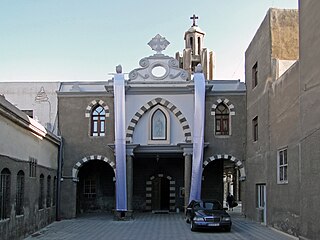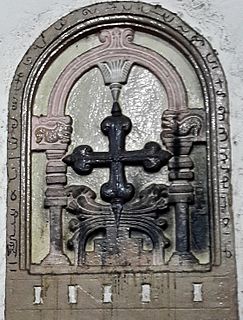
Eastern Christianity comprises Christian traditions and church families that originally developed during classical and late antiquity in Western Asia, Northeast Africa, Eastern Europe, Southeastern Europe, Asia Minor, the Malabar coast of South Asia, and parts of the Far East. The term does not describe a single communion or religious denomination.

The Syriac Orthodox Church, officially known as the Syriac Orthodox Patriarchate of Antioch and All the East, and informally as the Jacobite Church, is an Oriental Orthodox church that branched from the Church of Antioch. The bishop of Antioch, known as the patriarch, heads the church, claiming apostolic succession through Saint Peter in the c. 1st century, according to sacred tradition. The church upholds miaphysite doctrine in Christology, and employs the Divine Liturgy of Saint James, associated with James, the brother of Jesus. Classical Syriac is the official and liturgical language of the church.

The Syriac Catholic Church is an Eastern Catholic Christian originating in the Levant that uses the West Syriac Rite liturgy and has many practices and rites in common with the Syriac Orthodox Church. Being one of the twenty-three Eastern Catholic Churches, the Syriac Catholic Church is a self-governed sui iuris particular church church while it is in full communion with the Holy See and entirety of the Catholic Church.

Edessa was an ancient city (polis) in Upper Mesopotamia, founded during the Hellenistic period by King Seleucus I Nicator, founder of the Seleucid Empire. It later became capital of the Kingdom of Osroene, and continued as capital of the Roman province of Osroene. In Late Antiquity, it became a prominent center of Christian learning and seat of the Catechetical School of Edessa. During the Crusades, it was the capital of the County of Edessa.

Maron, also called Maroun or Maro, was a 4th-century Syrian Syriac Christian hermit monk in the Taurus Mountains whose followers, after his death, founded a religious Christian movement that became known as the Syriac Maronite Church, in full communion with the Holy See and the Catholic Church. The religious community which grew from this movement are the modern Maronites.

Onuphrius lived as a hermit in the desert of Upper Egypt in the 4th or 5th centuries. He is venerated as Saint Onuphrius in both the Roman Catholic and Eastern Catholic churches, as Venerable Onuphrius in Eastern Orthodoxy, and as Saint Nofer the Anchorite in Oriental Orthodoxy.

Saint Alexiusof Rome or Alexius of Edessa also Alexis) was a fourth-century monk who lived in anonymity and is known for his dedication to Christ. There are two versions of his life that are known, a Syriac one and a Greek one.

According to Eastern Christian tradition, Addai of Edessa or Thaddeus of Edessa was one of the seventy disciples of Jesus. He is possibly identical with Thaddaeus, one of the Twelve Apostles. From an early date his hagiography is filled with legends and fabrications. The saint himself may be entirely fictitious.

Saint John the Silent, also known as St John the Hesychast, was a Christian saint known for living alone for seventy-six years. He was given the surname because of his affinity for recollection and silence. St. John's feast day is May 13 in the Latin Rite of the Roman Catholic Church, and December 3 in the Eastern Orthodox and Eastern Catholic Churches.

The Synod of Diamper , held at Udayamperoor in June 1599, was a diocesan synod, or council, that created rules and regulations for the ancient Saint Thomas Christians of the Malabar Coast, a part of modern-day Kerala state, India, formally subjugating them and downgrading their whole Metropolitanate of India as the diocese of Angamale, a suffragan see to the Archdiocese of Goa administered by Latin Church Padroado missionaries. This synod also introduced many Latin practices in the liturgy of the Saint Thomas Christians which they had been following from centuries. The forced Latinization and disregard for the eastern and local tradition led to a massive protest by Saint Thomas Christians known as Coonan Cross Oath and subsequent schism among them the by mid-17th century.

The West Syriac Rite, also called Syro-Antiochian Rite, is an Eastern Christian liturgical rite that employs the Divine Liturgy of Saint James in the West Syriac dialect. It is practised in the Maronite Church, the Syriac Orthodox Church, the Syriac Catholic Church and various Malankara Churches of India. It is one of two main liturgical rites of Syriac Christianity, the other being the East Syriac Rite.

Antiochene Rite or Antiochian Rite designates the family of liturgies originally used in the Patriarchate of Antioch.

Palakunnathu Abraham Malpan, was an Indian cleric and theologian known for the Reformation movement within the Malankara Church during the 19th century. He was born in the ancient Syrian Christian Palakunnathu family which practiced West Syriac Rite Oriental Orthodoxy after the Coonan Cross Oath of 1653.

Eastern Christian Monasticism is the life followed by monks and nuns of the Eastern Orthodox Church, Oriental Orthodoxy, the Church of the East and Eastern Catholicism. Eastern monasticism is founded on the Rule of St Basil and is sometimes thus referred to as Basilian.

October 14 - Eastern Orthodox liturgical calendar - October 16

August 20 - Eastern Orthodox liturgical calendar - August 22

The Saint Thomas Christian denominations are traditional Christian denominations from Kerala, India, who trace their origins to the evangelistic activity of Thomas the Apostle in the 1st century. They are also known as "Nasranis" as well. The Syriac term "Nasrani" is still used by St. Thomas Christians in Kerala.

Several historical evidences shed light on a significant Malankara–Persian ecclesiastical relationship that spanned centuries. While an ecclesiastical relationship existed between the Saint Thomas Christians of India and the Church in Sassanid Empire in the earlier centuries, closer ecclesiastical ties developed as early as seventh century, when India became an ecclesiastical province of the Church of the East, albeit restricted to matters of purely ecclesiastical nature such as ordination of priests, and not involved in matters of temporal administration. This relationship endured until the Portuguese protectorate of Cochin of Malabar came to be in 16th century, and the Portuguese discovery of a sea route to India. The Christians who came under the two ancient yet distinct lineages of Malankara and Persia had one factor in common: their Saint Thomas heritage. The Church of the East shared communion with the Great Church until the Council of Ephesus in the 5th century, separating primarily over differences in Christology.
Ignatius George II was the Patriarch of Antioch and head of the Syriac Orthodox Church from 1687 until his death in 1708.
Saint Julian Sabas was a hermit who spent most of his life in deserted parts of Syria, but left his cell for a short period to denounce Arianism. His feast day is 14 January or 18 October in the Roman Church.












